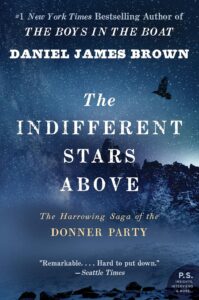The Indifferent Stars Above: The Harrowing Saga of the Donner Party – Daniel James Brown
 The Indifferent Stars Above: The Harrowing Saga of the Donner Party. By Daniel James Brown. (Boston: Mainer Books, 2009. pp. 384. Paper, $18.99.)
The Indifferent Stars Above: The Harrowing Saga of the Donner Party. By Daniel James Brown. (Boston: Mainer Books, 2009. pp. 384. Paper, $18.99.)
As every PhD student knows, one of the biggest events in your academic career is your comprehensive exam, popularly known as “comps.” You read near a hundred books and then have to be grilled on them for two hours with no notes. A staggering challenge.
I am abnormal in that I like this sort of exercise. I spent months prepping, participated in practice sessions, and overall felt pretty good about the whole thing when I sat down for the actual exam. And things indeed were going very well, until I well and good put my foot in my mouth, like I always do.
We were talking about Facing East from Indian Country, a book about encounters between Indigenous peoples and Europeans written from the Indigenous point of view. Because we don’t have the richness of sources on the way Indigenous peoples thought about their first encounters with Europeans, historian Daniel K. Richter read the sources in between the lines and used that to determine what might have been behind these encounters. I, very naively, expressed reservations about his methods, and everyone immediately jumped on me, rightly so.
The professor that had a assigned me the book put the value of such an approach in simple terms. In all the works on Thomas Jefferson, she said, no one ever mentioned him climbing stairs. But he was surrounded by them his whole life and must surely have made use of at least some of them. Given the facts you know with perhaps some common sense, it’s possible to make credible extrapolations. Since my comps I have read many, many books about Indigenous people that make use of Richter’s method, and I even reread Facing East from Indian Country and found nothing objectionable. Unfortunately, it was too late to salvage my comps.
In the “about the book” section at then end of The Indifferent Stars Above, the interviewer categorizes the book as narrative non-fiction (10). It reads to me like journalism. Author Brown centers his story one of the members of the Donner Party, Sarah Graves, and follows her tragic journey to California, attempting to understand what made such a human tragedy possible. The book deals with sensationalistic, yes, but not outrageously so. Brown is trying to tell a story of how ordinary people react to extraordinary hardship. In doing so, Brown uses Richter’s methods, extrapolating as much from the sources as he can, even going so far as to follow Graves’s overland trail himself, as detailed in the book’s conclusion.
Being trained in academic history, it is always interesting to read books of popular history written by popular historians. What is their methodology? How do they balance readability with building notes and bibliography of sources that allow scholars and others to trace their research without losing threads of what is compelling about the narrative? I know nothing about the Donner Party, so I have to read Brown’s footnotes and sources section to trace his trail of research. And there is also that extrapolation, that successful humanizing of the story to make it transcend mere narrative, something I think most historians struggle with a great deal.
Brown succeeds in developing human characters, contextualizing them in the broader narrative of western expansion. You know what is going to happen to the characters, but Brown does not exploit this ghoulish scenario as something to sensationalize. He gives humane and measured descriptions of the cannibalism that still haunts the story of the Donner Party. The Indifferent Stars Above is about that people behind the actions, not the actions themselves. And that makes the story all the more compelling.
Could you use this book in a classroom setting? I’m not sure. As I said, there is a lot here on the nature of westward expansion. The difficulties the Donner Party faced even before becoming snow bound for that one terrible winter cover the hardships of the journey westward, and what drove so many people to take the chance of that journey. The question becomes is there enough contextualization enough to use the cannibalism as a framing device, a hook to draw in students perhaps not so excited about the underlying subject. That being said, if used I would limit it to undergraduates.
No matter who we are and how we approach history, we can never truly know how everything happened, how people felt about, how they reacted. This is a very postmodern approach to take. But there are many, many voices that can tell us their own experiences and perhaps allow us to get an approximation, even a close one, to how events unfolded. Brown’s approach is just one attempt to get at that goal and, grim reality aside, it makes his book an enjoyable read, one worth entertaining as a history even in academic setting.
